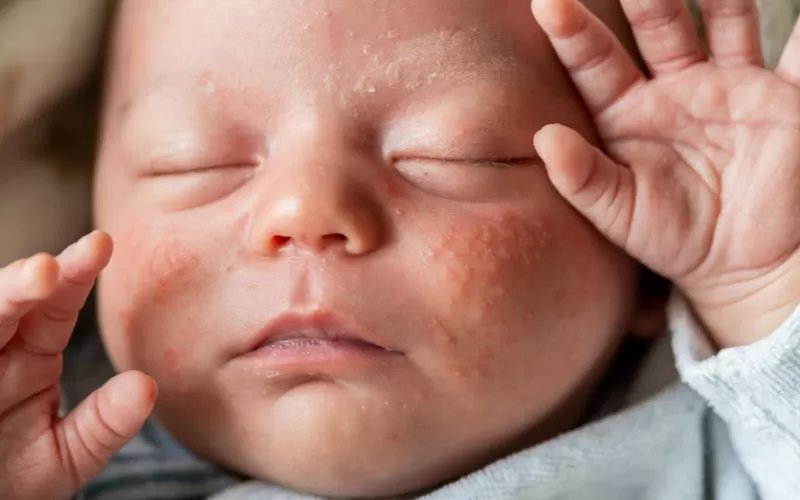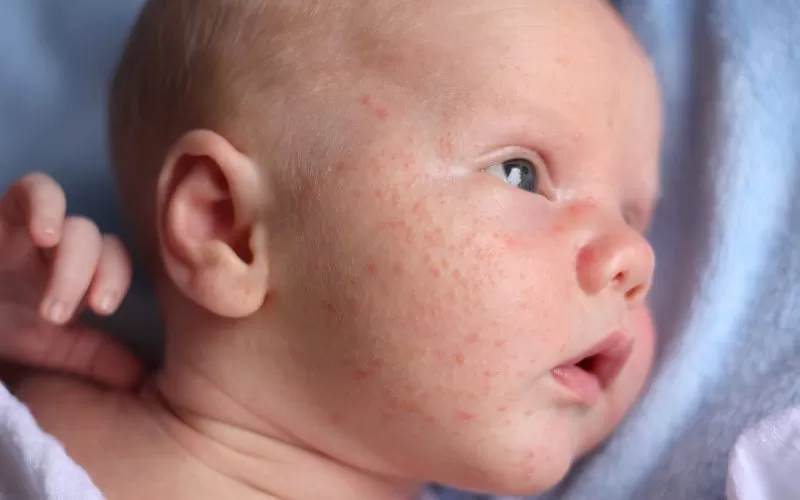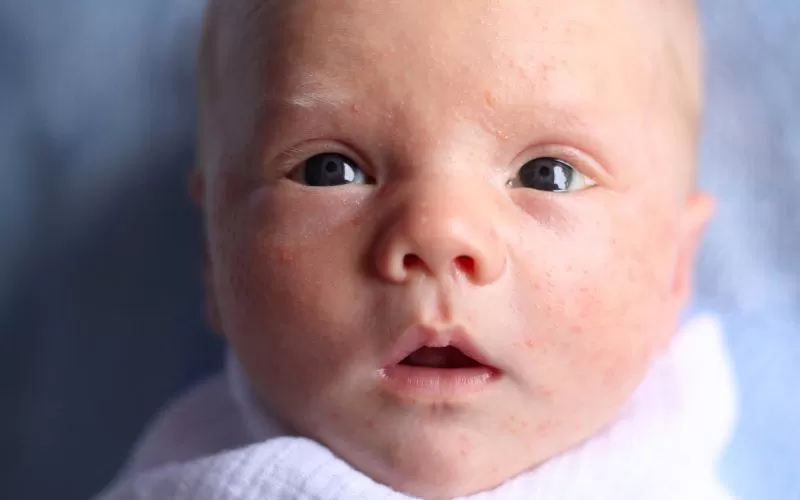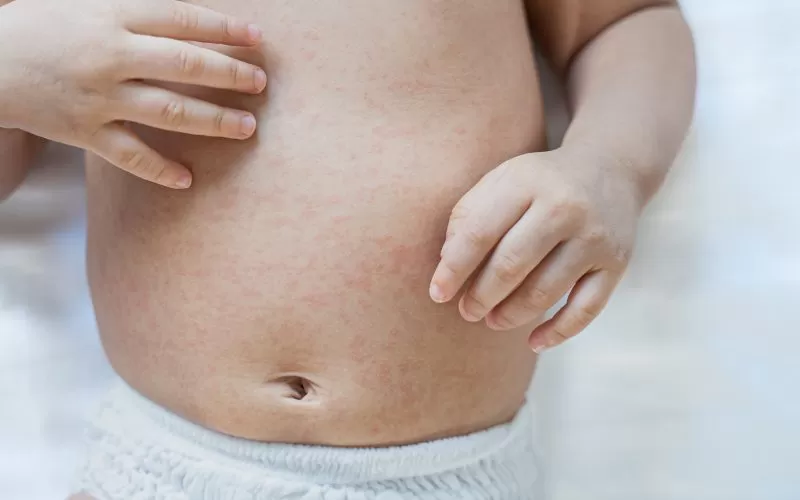Table of Contents
Manage Baby Acne Rashes
Baby acne and skin rashes are common skin conditions in newborns. These issues are often a concern for parents. However, most skin conditions in infants clear up on their own. However, understanding how to manage them can help ease your baby’s discomfort. It also ensures your baby’s skin stays healthy. In this article, we’ll explore what to know about baby acne, how to distinguish baby acne from other rashes, and provide practical tips for managing skin rashes. Along the way, we’ll recommend a few essential products from our store that can help soothe your baby’s delicate skin.
Baby acne and skin rashes can be concerning for new parents, but understanding their causes and how to manage them effectively is essential. According to leading baby dermatologists, baby acne is a common condition that usually clears up on its own within a few months. However, proper skin care routines can help speed up the healing process and ensure your baby’s skin stays healthy and soft.
What is Baby Acne?

Baby acne, also known as neonatal acne, usually appears in the first few weeks after birth. It is characterized by red or white bumps, mainly on the cheeks, forehead, and chin. While baby acne may look concerning, it’s generally harmless and doesn’t require medical treatment. However, managing it carefully can prevent irritation and keep your baby’s skin comfortable.
As parents navigate the challenges of baby acne and skin rashes, it’s essential to consider the overall skin health of your little one. To further support your baby’s delicate skin, it’s vital to prevent diaper rashes and skin irritation. Implementing practices such as regular diaper changes, using breathable fabrics, and applying protective ointments can significantly reduce the risk of rashes. For more comprehensive tips and strategies, check out our article on How to Prevent Diaper Rashes and Skin Irritation. By prioritizing proper skin care, you can help ensure your baby stays comfortable and rash-free.
What to Know About Baby Acne: Causes and Duration
What to know about baby acne is that it’s not caused by dirty skin or poor hygiene. Instead, it’s often linked to the hormonal changes your baby experiences after birth. These hormonal fluctuations can cause the oil glands to overproduce sebum, leading to clogged pores and acne-like spots.
Baby acne typically lasts for a few weeks to a few months. It usually clears up on its own. While it may be tempting to use over-the-counter acne treatments, it’s important to avoid them. Instead, use products specifically designed for a baby’s sensitive skin. For example, our Gentle Baby Face Wash is a perfect solution. It cleans your baby’s skin without harsh chemicals that can further irritate delicate skin.
How to Identify Baby Acne vs. a Rash

Distinguishing between baby acne and other skin conditions can be challenging. How to identify baby acne vs. a rash comes down to a few key differences. Baby acne appears as small red or white bumps, primarily on the face. In contrast, rashes like eczema or heat rash can cover larger areas and appear as patches or clusters of bumps. Eczema is usually itchy and often found on the arms, legs, and torso. Heat rash typically develops in areas where your baby sweats the most, such as the neck, back, and diaper area.
If you’re unsure, it’s always best to consult with your pediatrician, but for general skin irritation and mild rashes, using a product like our Natural Baby Moisturizing Lotion can help soothe the skin and reduce redness.
How to Get Rid of Baby Acne: Simple Care Tips

When it comes to how to get rid of baby acne, the key is to keep your baby’s skin clean and free from irritants. However, you should avoid using harsh treatments or scrubbing the skin, as this can lead to more irritation. Here are some tips for managing baby acne:
- Gently cleanse the skin: Use a mild, fragrance-free cleanser like our Soothing Baby Cleanser to wash your baby’s face once a day.
- Avoid heavy lotions and creams: While moisturizing is important for other rashes, baby acne usually doesn’t need additional creams. Heavy lotions can clog pores and worsen the condition.
- Don’t pick or scrub the acne: Picking at the bumps can lead to scarring and further irritation. Let the acne heal naturally.
As you navigate the world of caring for your newborn, it’s essential to be aware of common challenges they may face, such as sleep difficulties. For many parents, understanding and managing these sleep challenges can significantly improve both baby’s and parents’ well-being. If you’re dealing with skin issues like baby acne or rashes, you might also find that they can affect your baby’s sleep patterns. To learn more about how to address these sleep concerns and ensure your little one gets the restful sleep they need, check out our article on Common Newborn Sleep Challenges and How to Overcome them. This resource provides valuable insights and tips to help your baby settle into a peaceful sleep routine.
What to Know About Baby Acne vs. Eczema
In addition to understanding what to know about baby acne, it’s also essential to recognize the difference between baby acne and eczema. While baby acne is typically caused by hormones, eczema is usually linked to dryness or an allergic reaction. Eczema can cause rough, dry patches, and it may become worse in cold weather or after exposure to allergens like pollen, dust, or certain fabrics.
Treating eczema often involves using moisturizing products to prevent flare-ups. Our Hypoallergenic Baby Cream is specially formulated for babies with sensitive skin and can help soothe and protect against eczema outbreaks.
Managing Skin Rashes in Babies

Rashes are common in babies and can be caused by several factors, including allergies, heat, moisture, or reactions to products. Here are some common types of rashes and tips for managing them:
- Heat rash: This develops in hot and humid environments and appears as tiny red bumps. Keep your baby cool and dry, and dress them in loose-fitting, breathable clothes.
- Diaper rash: Diaper rash is caused by prolonged exposure to wet diapers. Change diapers frequently, use a barrier cream like our Organic Diaper Rash Balm, and allow your baby’s skin to air out.
- Eczema: As mentioned earlier, eczema can be managed with gentle moisturizers and avoiding triggers like harsh soaps and fragrances.
When managing baby acne and skin rashes, it’s crucial to also consider factors that may indirectly affect your baby’s skin health, such as sleep arrangements. Co-sleeping can sometimes lead to environmental factors that may irritate your baby’s delicate skin. Learn more about The Truth About the Risks of Co-Sleeping and how to create a safe and comfortable sleep environment that promotes overall health and well-being for your little one.
How to Get Rid of Baby Acne and Other Rashes
While how to get rid of baby acne usually involves gentle care and time, other rashes may require more specific treatments. For instance, if your baby has eczema, applying a thick, unscented lotion like our Natural Baby Moisturizing Lotion can help prevent flare-ups. For diaper rash, frequent changes and the application of a barrier cream will keep your baby’s skin protected.
Additionally, if you notice your baby scratching at their rash, try keeping their nails short and using mittens to prevent skin damage.
To maintain your baby’s delicate skin and prevent issues like acne and rashes, it’s crucial to follow a gentle and effective skincare routine. From choosing the right moisturizers to using mild, baby-safe cleansers, each step can make a significant difference in keeping your baby’s skin soft and healthy. For more comprehensive guidance, check out our Baby Skin Care 101: Essential Tips for Soft and Healthy Skin which covers everything you need to know about caring for your little one’s skin and preventing common skin concerns.
How to Identify Baby Acne vs. a Rash: When to See a Doctor
In most cases, baby acne and rashes resolve on their own with time and proper care. However, there are instances when you should consult a pediatrician. If your baby’s skin becomes swollen, oozes, or shows signs of infection (such as yellow crusting or a fever), it’s important to seek medical advice.
Recognizing how to identify baby acne vs. a rash and understanding the treatments for both can ensure your baby stays comfortable and rash-free. If you’re ever in doubt, your pediatrician can offer guidance on the best course of action.
Conclusion
Dealing with baby acne and skin rashes can be stressful, but with the right care and knowledge, you can keep your baby’s skin healthy and smooth. What to know about baby acne is that it’s a temporary condition that often resolves on its own, while rashes like eczema may require more ongoing management. By using gentle products like our Gentle Baby Face Wash, Natural Baby Moisturizing Lotion, and Hypoallergenic Baby Cream, you can effectively soothe your baby’s skin and manage these conditions.
Whether you’re learning how to get rid of baby acne or identifying how to identify baby acne vs. a rash, we hope this guide provides you with the tools and insights to keep your baby’s skin at its best.
While managing baby acne and skin rashes can be stressful for parents, ensuring your little one is well-rested is just as crucial for their overall health and development. Establishing a healthy sleep routine can reduce skin irritations caused by overtiredness or stress. If you’re struggling to get your baby to sleep soundly, check out our comprehensive guide on How to Sleep Train Baby: Finding the Right Approach for You This resource provides valuable tips to help you create a sleep training method that works best for your family, promoting better rest for both you and your baby.

